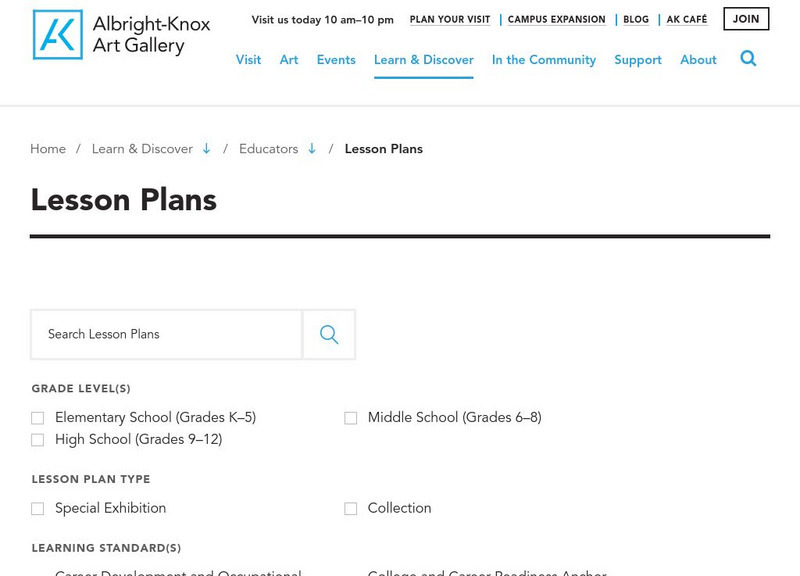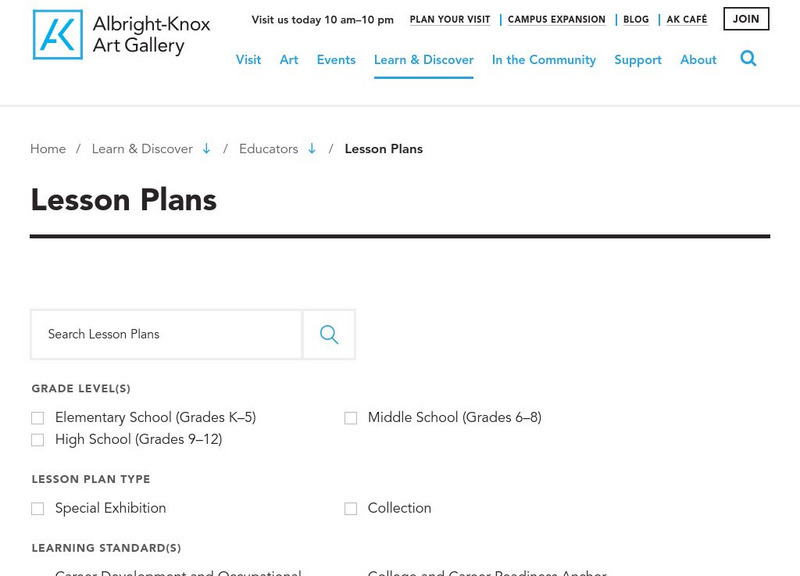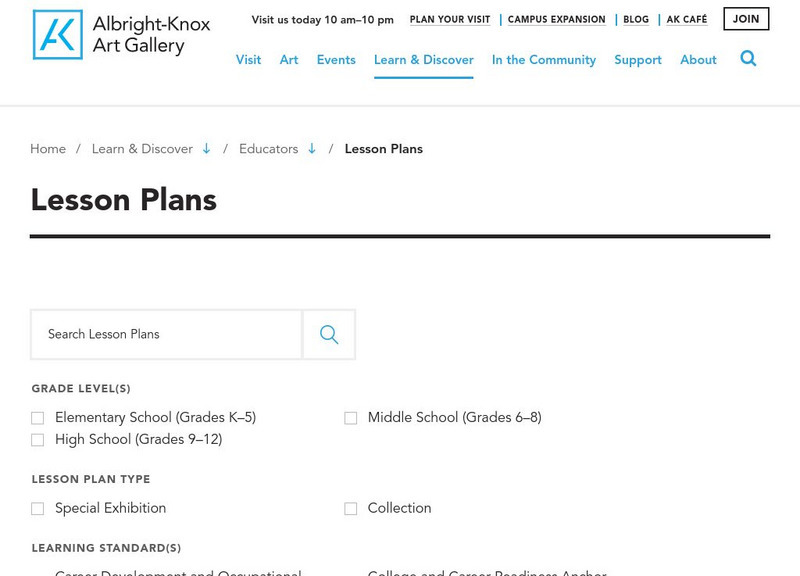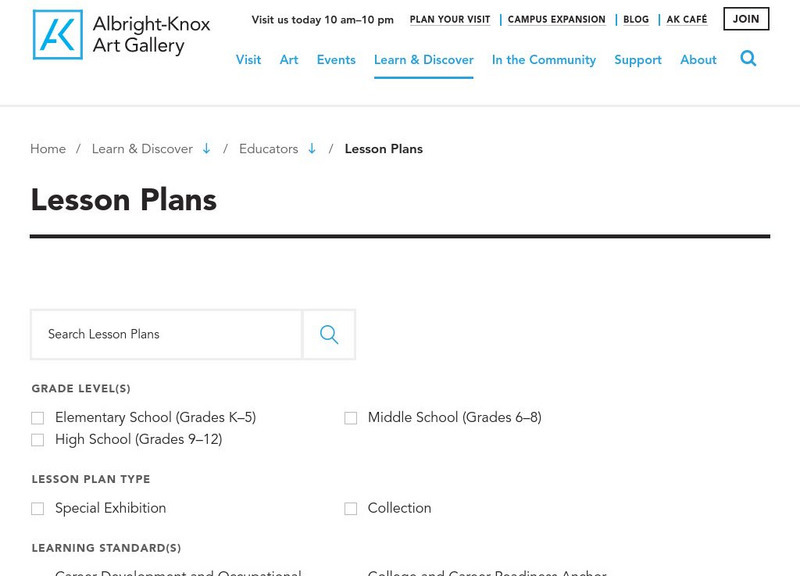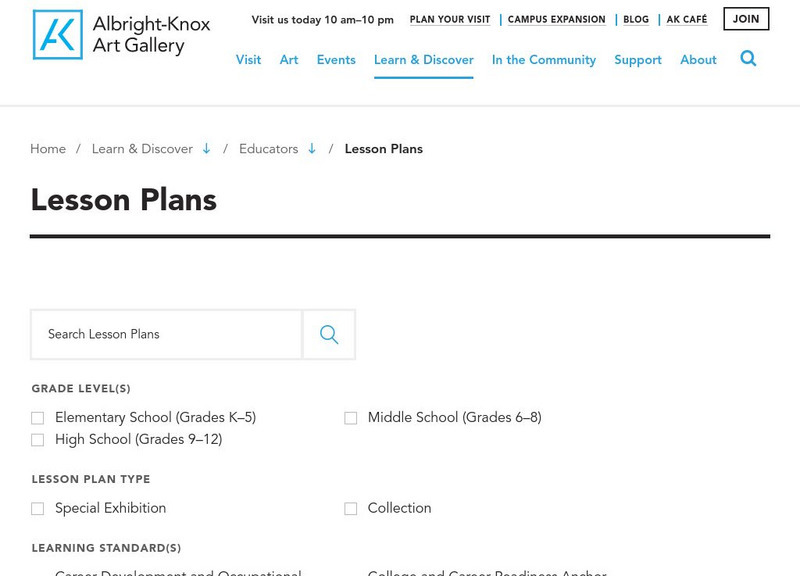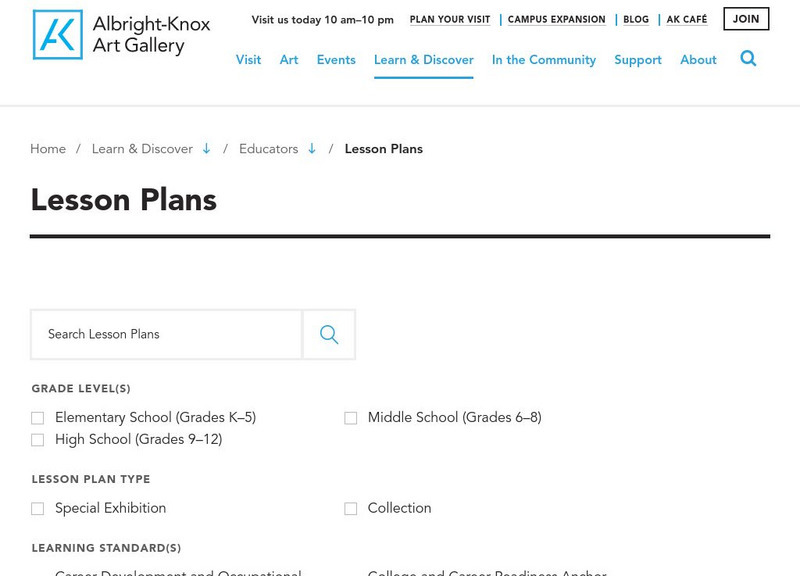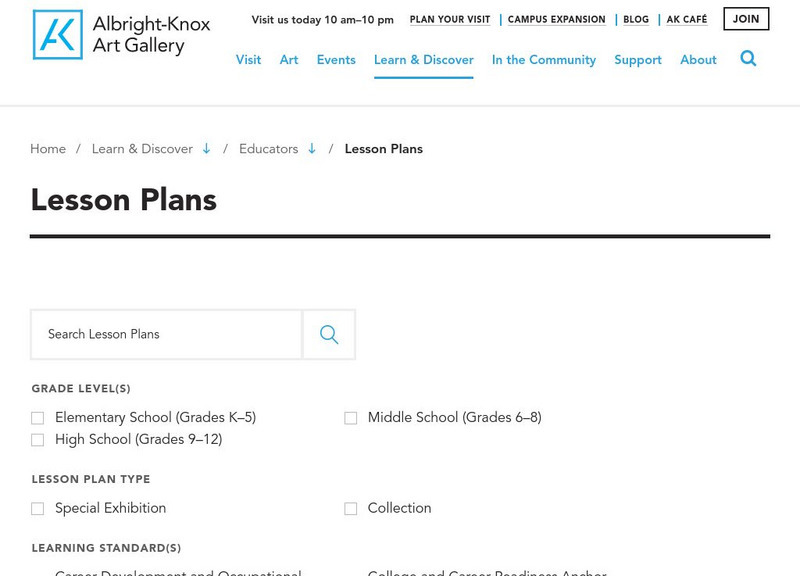Albright-Knox Art Gallery
Albright Knox Art Gallery: Collection Highlights
Numerous pieces of art are available to view. Students just click on the red "s" and get a larger image of the piece as well as some information and inquiry about the piece. Teachers get a more in-depth overview as well as activity...
Albright-Knox Art Gallery
Albright Knox Art Gallery: Kinetic Art Mobiles
Alexander Calder invented two new kinds of sculpture: mobiles and stabiles. In The Cone, he combines elements of each-a stabile, or non-moving sculpture, connected to a mobile, or moving sculpture. In this lesson, learners use their...
Albright-Knox Art Gallery
Albright Knox Art Gallery: 3 D "Special Space" Painting
Jim Dine's Child's Blue Wall combines sculpture and painting. It is both a realistic depiction of a child's bedroom and an abstract painting of a night sky. This lesson plan explores how Dine accomplished these two ideas in the same work...
Albright-Knox Art Gallery
Albright Knox Art Gallery: Can It?
Pop artists used consumer products, advertising, and popular culture icons as the major source for subject matter in their art. Between 1962 and 1967, Andy Warhol painted soup cans, both individually and in groups. 100 Cans is one of the...
Albright-Knox Art Gallery
Albright Knox Art Gallery: Personified Sculpture
After learning about Fernand Leger's sculpture, students will learn basic concepts of modern dance, create their own movements, select sounds or music, and combine all of these in a modern dance performance.
Albright-Knox Art Gallery
Albright Knox Art Gallery: Double Vision
Pablo's Picasso's La Toilette is a loving portrait of Fernande Olivier, as well as a study in opposites and a reference to the history of art. In this lesson, students will discover the many levels of content in the painting through...
Albright-Knox Art Gallery
Albright Knox Art Gallery: Experiencing Video Art
Students will become familiar with the artist Kelly Richardson and her video work Twilight Avenger, 2008, and create a connection with Twilight Avenger through art, literature, and technology.
Albright-Knox Art Gallery
Albright Knox Art Gallery: How Observant Are You?
Pop artists of the 1960s encouraged people to look more closely at the everyday objects around them. How observant are your learners? This lesson plan focuses on observation, memory, and home and classroom environments.
Albright-Knox Art Gallery
Albright Knox Art Gallery: Imagine Your Own Civilization
Charles Simonds imagines a race of people he calls the Little People, who have their own history, beliefs, and ways of life. His sculptures, such as Number II (Ritual Furnace), represent their environment and the architecture they...
Albright-Knox Art Gallery
Albright Knox Art Gallery: Having Fun With Landscape Photography
John Pfahl used creativity, strategic placement of objects, changing vantage points, and a sense of humor to create his Altered Landscape series of photographs. Students will learn about his artist statements and methods and then create...
Albright-Knox Art Gallery
Albright Knox Art Gallery: Having Fun With Landscape Photography
Students will learn about horizon lines in traditional landscapes and portraits, shadows and reflected light, and John Pfahl's Altered Landscapes. They will also create their own altered landscape photographs and portraits and write...
Albright-Knox Art Gallery
Albright Knox Art Gallery: Natural Materials
Students will learn that artists like David Nash use natural materials such as wood to create works of art that incorporate principles of design such as balance, repetition, rhythm, and unity. They will collect their own natural...
Albright-Knox Art Gallery
Albright Knox Art Gallery: Paul Sharits: Thinking in a New Way About Movies
Information about 16mm films made by Paul Sharits is packed into his two-dimensional drawings on graph paper. Students will learn about how film works to understand how to translate Sharits's drawings into information about his films....
Albright-Knox Art Gallery
Albright Knox Art Gallery: Grid Self Portrait
This lesson plan explores how Chuck Close uses photography and a mathematical grid to create his large portraits. Hands-on activities encourage students to create using the grid, during which they will learn about variation, repetition,...
Albright-Knox Art Gallery
Albright Knox Art Gallery: Shape and Line Remix
Sol LeWitt used ideas as his artwork, a method of artmaking that has become known as Conceptual art. From each idea, many drawings, prints, or sculptures could be created. Young scholars will use simple geometric shapes as creative...
Albright-Knox Art Gallery
Albright Knox Art Gallery: Painting an Impression
Impressionists used new methods of mixing colors based on contemporary scientific writings about optics. This lesson plan explores the theory of optical color mixing, painting the same subject under different conditions of light, and the...
Albright-Knox Art Gallery
Albright Knox Art Gallery: Three Ways to Make a Scene
Students will analyze landscapes by three artists. After learning about the horizon line, they will create their own painted and collaged landscapes inspired by one of the artists.
Albright-Knox Art Gallery
Albright Knox Art Gallery: It All Adds Up to Art
Lorna Simpson creates evocative works that examine how combinations of pictures and texts create new meanings that do not exist in the images or words alone. This lesson plan explores the concepts she works with, including African...
Albright-Knox Art Gallery
Albright Knox Art Gallery: Experiencing Sculpture
Students will become familiar with three sculptures by Mona Hatoum, Jennifer Steinkamp, and Erwin Wurm, and observe and respond to sculpture through the use of discussion, writing, and artmaking.




